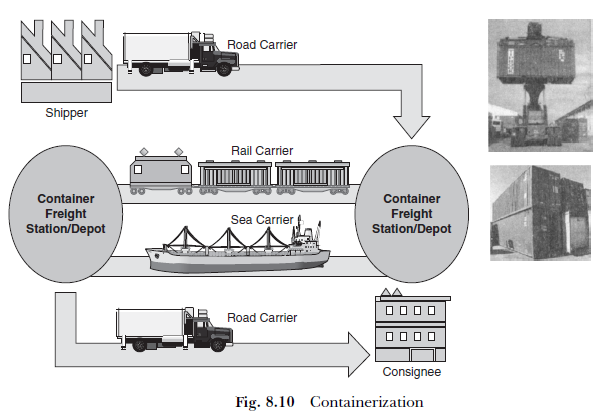Containerization is making waves in the transportation of goods, ensuring manifold benefits to the users, transport companies and the country’s economy. A container can be defined as a transport device for moving solid or liquid material. It is a case or a tank with adequate strength to be repeatedly used for packing and transportation of the material. The container can be used on several transport modes without material being stuffed, destuffed or trans-shipped.
Today containerization is an accepted trend in shipping for international and domestic trade. Initially containers were used for sea transportation, but are now profusely used in inland transportation. It was Malcolm McLean, owner of a huge trucking company in the USA, who conceived the idea of containers in 1956. Containerization in shipping started in the 1960s; the first container shipping being ‘Hawaiian Citizen’. It defined the system of port management with vision and strategic planning and developed sophisticated handling facilities. Since then, the container traffic has grown in leaps and bounds, and more than 470 million TEU (of 20 ft container) were handled world over in 2009. This is expected to grow to 700 million TEUs by 2015, with largest growth being expected in Asia. Globally, containerization is expected to grow at 5 per cent in the next 10 years and in Asia at 8-10 per cent.

Ports and shipping industry world over has accepted that containerization is the future of shipping and initiated projects for keeping pace with the latest developments. The ship builders have already started building huge container carrier cargo ships having capacity of more than 6000 TEUs. The ports are also gearing up to meet these challenges. Some ports such as Heliex, Canada, have already taken action to deepen the container birth for maintaining the draft of at least 52 feet to receive ships with 8000 TEU or above. The containers used for movement of solid cargo are box type construction with side or top opening with twist locking system. These are normally water and air tight constructions using steel or aluminium alloy, and are built as per International Standard Organization (ISO) having common sizes as indicated in Table 8.5.
The factors that contributed to the growth of container traffic are:
- Integration of various modes of transportation—Possible Inter-modal transportation
- Elimination of cargo trans-shipment leading to speedier delivery service
- Possible door-to-door service to customers
- Reduced risk of transit damage and pilferage
- Substantial reduction in logistical packaging cost of the goods
- Reduction in distribution cost
1. Scope of Containerization: Some Highlights
- I ndia’s annual GDP growth is very high (compared to other countries); logistics sector, being an integral part of the growth engine, and is expected to grow at 15-20 per cent over the next few years.
- India’s exim trade had a growth of 24 per cent annually between 2002 and 2007, and the Indian government has targeted to raise India’s share in global trade from 0.8 to 1.6 per cent in the next five years.
- I ndian industry spends 12-13 per cent on logistics costs, and a large scope to rationalize this expenditure means more opportunities to containerization.
- India’s container cargo has grown at 16-17 per cent annually for the past four years, and the growth is expected to continue because of surge in foreign trade and growing port capacities.
- Globally, containers account for 80 per cent of cargo volumes, In India, penetration level of container is 45 per cent. India’s National Maritime Development programme predicts container traffic to grow 15 per cent annually between 2007 and 2014.
- Container handling capacity at all Indian ports is expected to rise to 14.2 million TEUs in 2014 from 6 million TEUs in 2007.
- The share of railways in container train movement is expected to rise from the current level of 30 to 40 per cent in FY14.

The container services in India were started in 1966 and initially containers with payload of 5 tonnes were introduced. IR first started container service between Mumbai and Ahmedabad in 1968. However, slowly the railway rakes were developed to adopt the large size containers of 20 feet and 40 feet length. Till 1988, the growth of container traffic was very slow. However in 1988, Container Corporation of India (CONCOR) under the Ministry of Railways was formed to look after the container traffic in India (Table 8.6).

This resulted in speedier development of container handling (cranes, trailers, reach stacker, heavy duty fork lifts, side loaders) and movement (special railway rakes, container trucks) facilities in the country at various locations. Growth rate during the last few years observed in container traffic in India was 16-17 per cent per annum. Last year, CONCOR handled 2.20 million TEUs (of 20 ft container) of container traffic. CONCOR has monopoly position in container handling with 60 per cent share in inland container traffic. It has a network of 17 Inland Container Depots (ICDs), 7 Container Freight Stations (CFSs), 5 Port Side Container Terminals (PSCTs), and 10 Domestic Container Terminals (DCTs) to handle the growing container traffic in the country. To take care of the container traffic, CONCOR has its own inventory of various sizes of containers, and in addition Indian Container Leasing Company in private sector is engaged in leasing containers to transporters and corporate.

Source: Sople V.V (2013), Logistics Management, Pearson Education India; Third edition.

Wow! Thank you! I continually wanted to write on my site something like that. Can I include a portion of your post to my website?